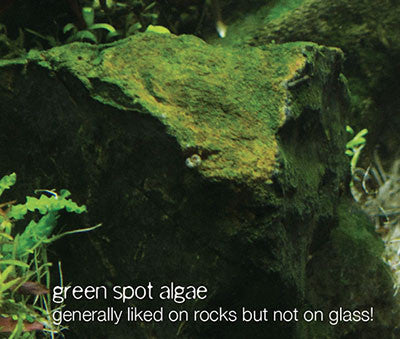Algae you might encounter

Foreword:
Algae comes in many forms and is universally unwanted except for some green spots on rock that gives it a "mature" look.
The most common are tiny floating ones, long slimy strands, green spots, short bushy tufts and also slimy brown, blue green ones.
They generally come piggy backing from plants/fishes or spores that land in your tank.
What we know is if the plants are not doing well due to a key nutrient being in short supply and there is an over abundance of light, algae will thrive and overtake the tank. As such, controlling lighting is an effective treatment of algae in all cases.
Aquatic plants, being higher organisms with larger resource stores can weather light deprivation[not zero] and survive periods up to a month in our experience.
We generally recommend using this method together with a clean up crew[CUC] and manual cleaning to remove algae.

Green water happens when small floating algae reproduces rapidly to cloud the water in a greenish tinge. The cause is generally too much light and nutrients like ammonium. Usually happens in new tank setups with soil rich in ammonium.The simplest method to get rid of it in our experience is by turning off the lights for 4-5 days and not dose any trace fertilisers with iron content. This blackout stunts the algae and gives the tank time to stabilise.
A 50% water change is recommended on the 1st and 5th day of blackout to further reduce the algae count. This lights off method does not involve covering the tank. A portable Ultraviolet Steriliser[UVS] pump can be added to hasten the process.
It can be persistent but blackout together with the UVS is 100% successful even in very thick green pea soup situations.

This algae is generally appears and noticed by us when we use cosmetic white sand that contains silicates. It feels soft and slimy to the touch and can be dark grey to brown in appearance with soft branchy filaments.
Being a hairy algae, it is consumed by Siamese Algae Eaters[SAE] and Yamato Shrimps. Best not to feed any food during treatment so that the algae eaters can focus on eating the hairy diatoms.
Treatment could last two weeks depending on how many algae eaters and the severity of the problem. A short blackout of 4-5 days also helps soften up this type of algae for the CUC.
Clean Up Crew (CUC) Your best friend for tackling algae!
These are the fellas that will help you tackle filamentous & slimy algae

|
SAE - Very effective in clearing out filamentous algae when it's around 2.5-6cm size. Could damage plants and be "lazy" when larger.
|
Otocinclus - Good nibbler of filmy algae except blue green algae. Gentle on plant leaves.
|
Yamato Shrimp - Voracious filamentous algae eater that also scavenges around the tank for other types of waste and leftover food. May attack plants when hungry.
|
Types of Algae
and how you tackle them

Algae A) This algae grows very rapidly and can take over the tank in a week if not attended to immediately.
This is often cause by neglect and generally unfavourable conditions for plant growth such as lack of CO2 or other key nutrients but with an over abundance of light.
This algae grows very rapidly and can take over the tank in a week if not attended to immediately.
Algae B) This is often caused by neglect and generally unfavourable conditions for plant growth such as lack of CO2 or other key nutrients but with an over abundance of light.
This algae likes to adhere to the side of the tanks, plants and anywhere close to the light.The best method in our opinion is still using a large number of CUC- clean up crew such as SAE and Yamato shrimps to tackle it together with manual removal of the algae with a net & toothbrush.

Algae C) As it is light loving, a short 4-5 day blackout works well to soften up this algae for the CUC to devour. Remember not to feed during this treatment period.
UVS is not effective in treating this type of algae.
Algae D) These three have mysteriously showed up in our tanks. They are quite persistent and grow almost as quickly Green Slime Hair Algae.The difference is it's not as slimy and can feel slightly matted.

Algae E) The colour varies from green to grey green to black.It also appears on tips of moss as black tips!Treatment is the same as for Green Slimy Hair Algae.
Algae F) Here it looks branchy and dry due to low nutrient conditions.
